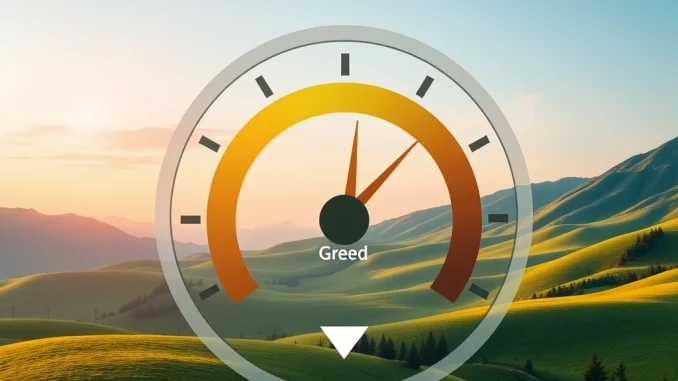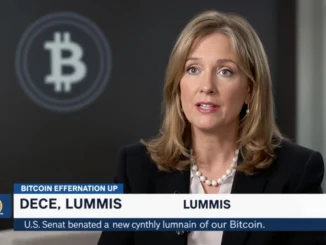
The pulse of the cryptocurrency market is often measured not just in price charts, but in collective emotion. The **Crypto Fear and Greed Index**, a popular tool among traders and investors, provides a snapshot of this sentiment. As of April 25, the index, provided by Alternative, registered a value of 60. While this score firmly places the market in the ‘Greed’ zone, it represents a three-point decrease from the previous day. This slight dip, though keeping the index out of ‘Extreme Greed’, sparks questions about the market’s current emotional state and potential next moves.
What Exactly is the Crypto Fear and Greed Index?
Think of the **Fear and Greed Index** as a barometer for the crypto market’s mood. It aims to quantify the dominant emotion driving market behavior at any given time. The index operates on a simple principle: extreme fear can signal a potential buying opportunity (as investors panic sell), while extreme greed might suggest the market is due for a correction (as investors become overly confident and buy aggressively). It ranges from 0 (representing ‘Extreme Fear’) to 100 (representing ‘Extreme Greed’).
The index is broken down into several zones:
- 0-24: Extreme Fear
- 25-49: Fear
- 50-54: Neutral
- 55-74: Greed
- 75-100: Extreme Greed
Understanding the Recent Drop in the Fear and Greed Index
The index’s movement from 63 to 60, while minor, is worth noting. Staying within the ‘Greed’ zone means the prevailing sentiment is still positive – people are generally willing to buy and hold, perhaps expecting prices to rise further. However, the three-point drop suggests a slight cooling of that optimism. It could reflect minor price corrections, profit-taking, or general market uncertainty creeping in. It’s a reminder that sentiment is dynamic and can shift quickly, even within the same zone.
How is the Fear and Greed Index Calculated?
The index isn’t based on a single factor but aggregates data from six different sources to provide a comprehensive view of **crypto market sentiment**. Each factor is weighted differently:
- Volatility (25%): Measures the current volatility and maximum drawdown of Bitcoin compared to its average values over the last 30 and 90 days. Higher volatility often indicates fear.
- Market Momentum/Volume (25%): Compares the current volume and market momentum to the average values over the last 30 and 90 days. High buying volume in a positive market is a sign of greed.
- Social Media (15%): Analyzes posts on platforms like Twitter, focusing on specific hashtags and the speed and count of posts. High interaction rates around positive sentiment can indicate greed.
- Surveys (15%): Polls users on their market outlook (though this factor is currently paused).
- Bitcoin Dominance (10%): Measures Bitcoin’s share of the total crypto market cap. Increasing Bitcoin dominance can signal fear (as investors move to the perceived safety of BTC) or greed (if BTC is leading a strong rally).
- Google Trends (10%): Analyzes search queries related to Bitcoin and other cryptocurrencies. Spikes in search terms like “Bitcoin price manipulation” might indicate fear, while terms like “buy crypto” could suggest greed.
Why Does Crypto Market Sentiment Matter?
Understanding **crypto market sentiment** is crucial because emotion plays a significant role in price movements. Fear can lead to panic selling, driving prices down rapidly. Greed, on the other hand, can fuel FOMO (Fear Of Missing Out), leading to aggressive buying and potentially inflated prices. The **Fear and Greed Index** offers a way to gauge this collective psychological state, providing context for price action beyond just charts and technical analysis.
Many traders use the index as a potential contrarian indicator. The saying goes: “Be fearful when others are greedy, and greedy when others are fearful.” A very high index might signal a time to be cautious, while a very low index could suggest a potential opportunity, assuming underlying fundamentals are sound.
Navigating the ‘Greed’ Zone: What 60 Tells Us About Bitcoin Fear and Greed
Being at 60 means the market is still generally optimistic, but it’s not in a state of extreme euphoria. This moderate ‘Greed’ score suggests that while buyers are in control, there might be underlying caution or resistance preventing the index from soaring into the 70s or 80s. For **Bitcoin Fear and Greed**, specifically, a score of 60 indicates positive sentiment driven by Bitcoin’s performance and market activity, but it’s far from the levels seen during major bull run peaks where scores can hit 90+. It could represent a healthy period of accumulation or consolidation within an uptrend, rather than an imminent blow-off top.
The current position within the **crypto greed zone** at 60 could be interpreted in a few ways:
- Positive but Not Overheated: The market is trending positively, but isn’t yet showing signs of extreme speculative excess.
- Potential for Swings: A score in the lower ‘Greed’ zone can be more volatile than ‘Extreme Greed’ or ‘Extreme Fear’, susceptible to quicker shifts based on news or price action.
- Confirmation of Trend: If the market is in an uptrend, a ‘Greed’ score confirms that sentiment aligns with the price movement, suggesting underlying strength.
Challenges and Limitations
While a valuable tool, the **Fear and Greed Index** is not perfect. It’s a composite index based on specific data points, and its methodology can change. It’s also largely backward-looking, reacting to market movements and sentiment that have already occurred. It cannot predict future events or guarantee market direction. Relying solely on the index for investment decisions is risky. It should be used as one tool among many, alongside technical analysis, fundamental analysis, and careful risk management.
Conclusion: Keeping a Pulse on Sentiment
The **Crypto Fear and Greed Index** dropping slightly to 60, while remaining in the ‘Greed’ zone, serves as a subtle signal in the dynamic world of cryptocurrency. It confirms continued positive **crypto market sentiment** but hints at a possible moderation of enthusiasm compared to recent highs. Understanding how this index is calculated and what its different zones signify provides valuable context for market participants. While it’s not a crystal ball, keeping an eye on the **Fear and Greed Index crypto** offers a unique perspective on the emotional forces shaping the market, complementing other analytical approaches for navigating the exciting, and sometimes volatile, landscape of digital assets.



